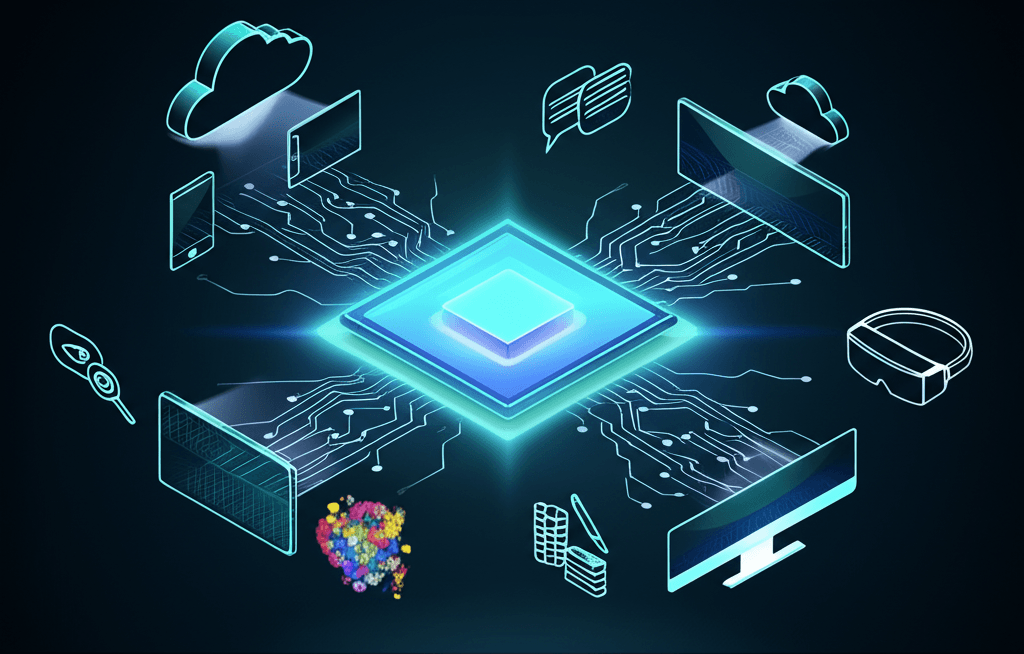Apple Intelligence Debuts: Private, Powerful AI Weaves Across Ecosystem
Apple's WWDC reveals: powerful, personal, and private AI deeply integrated across its entire ecosystem.
June 9, 2025

Apple significantly expanded its suite of artificial intelligence features, collectively known as Apple Intelligence, with a series of announcements at its Worldwide Developers Conference (WWDC). These updates, slated to roll out this fall, aim to enhance user experiences across iPhone, iPad, Mac, Apple Watch, and Apple Vision Pro by deeply integrating AI into the operating systems and providing new tools for communication, productivity, and creativity.[1][2] The company emphasized that these new capabilities are built with privacy at their core, leveraging on-device processing and a new Private Cloud Compute infrastructure to handle more complex requests without compromising user data.[3][4]
A key theme of the announcements was the evolution of Apple Intelligence to be more powerful and context-aware.[1][5] This includes new capabilities in visual intelligence, allowing users to interact more intuitively with content on their screens.[1][2][6] For instance, users can search for items or information based on what's displayed in an app, or even ask questions about on-screen content with the help of an integrated ChatGPT feature, which requires explicit user permission before sharing data with OpenAI.[2][7] Visual intelligence can also recognize events on screen and suggest adding them to the calendar, automatically extracting relevant details like date, time, and location.[2][8] This builds upon existing visual search capabilities that use the device's camera.[2][9] To access visual intelligence for on-screen content, users can press the same buttons used for taking a screenshot.[1][10]
Communication tools received a significant boost with the introduction of Live Translation, a feature designed to facilitate real-time text and voice translation across Messages, FaceTime, and Phone calls.[1][2][11] This functionality processes translations on-device, ensuring conversations remain private.[2] Enhancements to creative expression were also prominent, with updates to Image Playground and Genmoji.[1][2] Image Playground now offers new styles and an "Any Style" option, alongside ChatGPT integration for generating images when users have a specific idea.[1][2] Genmoji allows users to create personalized emoji-like characters by blending existing emojis with descriptive prompts, or even combining different Genmoji and descriptions.[2][11][7][8] Existing Writing Tools, which offer rewriting, proofreading, and summarization capabilities system-wide, continue to be a core part of Apple Intelligence.[1][12][13][14][15] These tools can adjust the tone of text, check for grammar and word choice, and condense lengthy documents or emails into key points.[5][12][16]
Underpinning these new user-facing features is a significant step for developers: Apple is opening up access to its on-device foundation models through the new Foundation Models Framework.[1][2][6][17][18][19][20] This framework allows developers to integrate Apple Intelligence directly into their third-party apps, tapping into powerful, private, and offline-capable AI processing at no additional inference cost.[1][2] App developers can use Swift to easily access these models, enabling a new wave of intelligent experiences, such as personalized quizzes generated from a user's notes within an education app or natural language search in an outdoors app that works offline.[1] Shortcuts are also becoming more intelligent, with the ability to tap directly into Apple Intelligence models, either on-device or via Private Cloud Compute, to generate responses that can be incorporated into automated workflows.[1] This allows users to build more powerful and personalized automations.[1][19]
Apple reiterated its strong commitment to privacy, emphasizing that many Apple Intelligence features operate entirely on-device.[3][21][4][22] For more complex tasks requiring greater computational power, Apple introduced Private Cloud Compute.[3][4][23][24][13] This system processes user data on servers powered by Apple silicon, ensuring that data is never stored or made accessible to Apple and is used solely to fulfill the user's request.[3][4] Apple has stated that independent experts can inspect the code running on these servers to verify this privacy promise.[3][21][24] This approach aims to set a new standard for privacy in AI, allowing users to benefit from advanced intelligence without sacrificing control over their personal information.[3][21][22] While some analysts note that Apple's AI rollout has been more measured compared to some competitors, the focus on deep integration, user experience, and privacy is seen as a strategic differentiator.[25][26][22][27][28][29][30][31] The company is also expanding language support for Apple Intelligence, with eight more languages expected by the end of the year.[1][2] However, some reports indicate that a more significant overhaul of Siri, particularly its personalized and multi-app contextual awareness, might take longer to fully materialize, potentially arriving in 2026.[25][32][10][27][33][34][19][31][35][36]
The implications of these updates for the AI industry are substantial. Apple's emphasis on on-device processing and Private Cloud Compute could push competitors to adopt more stringent privacy measures.[37][30] By providing developers with direct access to its foundation models, Apple is fostering a potentially vast ecosystem of AI-powered apps that adhere to its privacy principles.[1][37][18] This could lead to new revenue streams for Apple through enhanced premium features and a more attractive developer ecosystem.[37] While Apple has integrated ChatGPT for certain functionalities, its core strategy appears to be building out its own robust AI capabilities that are deeply embedded within its hardware and software.[2][7][34][9][24] This deliberate, privacy-centric approach, while perhaps slower to market with some features, aims to build user trust and differentiate Apple in an increasingly competitive AI landscape.[26][22][28][37][29][30]
In conclusion, the WWDC announcements paint a clear picture of Apple's strategy to weave powerful, personal, and private AI into the fabric of its entire product ecosystem. From enhanced communication and creative tools for users to new frameworks empowering developers, Apple Intelligence is poised to significantly reshape how millions interact with their devices. The company's unwavering focus on privacy, through on-device processing and Private Cloud Compute, sets a distinct tone in the AI industry, potentially influencing future development trends and user expectations for intelligent, trustworthy technology.
Sources
[1]
[2]
[3]
[4]
[7]
[8]
[9]
[10]
[11]
[12]
[13]
[14]
[15]
[16]
[17]
[18]
[21]
[23]
[25]
[26]
[27]
[30]
[31]
[32]
[33]
[35]
[36]
[37]